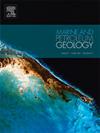The Garn Formation in the Maria and Lavrans Fields, Central Halten Terrace, Norwegian Continental Shelf: Sedimentological features and depositional history
IF 3.7
2区 地球科学
Q1 GEOSCIENCES, MULTIDISCIPLINARY
引用次数: 0
Abstract
We describe the sedimentological features of the Middle Jurassic Garn Formation accumulated in the central sector of the Halten Terrace, Norwegian Continental Shelf. The Garn Formation is a siliciclastic sandstone-rich succession, exhibiting a variety of cross stratification that have been investigated by a series of previous studies thanks to its many hydrocarbon-bearing sandstone intervals. Because of its variable sedimentological character and the complex structural setting of the region where the unit is present, the Garn Formation has been attributed to a wide range of different depositional settings. As such, no clear process or environmental identification exists for this formation, potentially hampering exploration and production strategies.
Here we investigate six wells recording the Garn Formation in the Maria and Lavrans fields, covering a total of 190 m of cored intervals. Gamma-Ray-based stratigraphic trends suggest that the Garn Formation initially accumulated during a period of forced regression and lowstand and subsequently during a long-lasting phase of transgression punctuated by stages of normal regression. Facies analysis identifies six recurrent lithofacies in the generally sandstone-dominated strata, where very-well sorted medium-grained arenites exhibiting hierarchies of cross stratification and alternating fine-grained intervals, are the most recurring sedimentological motifs recognisable in many of the analysed core intervals.
Our interpretation suggests a marine, sub-tidal depositional setting, where the dominant process of sediment transport and accumulation was exerted by tidal currents, flowing prevalently in a SSW direction and promoting the formation of a series of sand shoals and banks, hosting superimposed smaller bedforms (i.e., bars and dunes). These large-scale composite sand bodies were in places separated by bathymetrically-deeper inter-dune areas, which were prone to mud accumulation and bioturbation by organisms preferring quieter hydrodynamic conditions. During an initial period of relative forced-regressive conditions and shallow water, the top of these sand accumulations might have been reworked by waves and incised by shallow channels generated by tidal flows.
The elongation of the dune fields, as well as the presence of similar reservoir bodies in the area, and the orientation of normal faults dissecting this part of the Halten Terrace during the Middle Jurassic, sustain the hypothesis of a wide marine seaway (i.e., the Laurasian Seaway), connecting the Boreal Ocean in the north and the Tethys Ocean in the south.
求助全文
约1分钟内获得全文
求助全文
来源期刊

Marine and Petroleum Geology
地学-地球科学综合
CiteScore
8.80
自引率
14.30%
发文量
475
审稿时长
63 days
期刊介绍:
Marine and Petroleum Geology is the pre-eminent international forum for the exchange of multidisciplinary concepts, interpretations and techniques for all concerned with marine and petroleum geology in industry, government and academia. Rapid bimonthly publication allows early communications of papers or short communications to the geoscience community.
Marine and Petroleum Geology is essential reading for geologists, geophysicists and explorationists in industry, government and academia working in the following areas: marine geology; basin analysis and evaluation; organic geochemistry; reserve/resource estimation; seismic stratigraphy; thermal models of basic evolution; sedimentary geology; continental margins; geophysical interpretation; structural geology/tectonics; formation evaluation techniques; well logging.
 求助内容:
求助内容: 应助结果提醒方式:
应助结果提醒方式:


